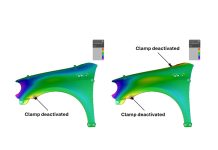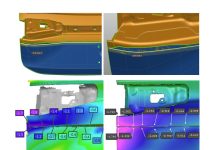When is an equivalent not an equivalent? Understanding the challenges behind equivalent material grades
The clever folks in our social media marketing department previously published a post on the forming of the Mandalorian Helm from the smash hit TV series of the same name. The post has garnered some real traction, provoking a barrage of feedback and questions sent to AutoForm regarding the helm’s production. Here’s an interesting question I received from the team: “Does AutoForm offer a material card for Mandalorian Iron (otherwise known as ‘Beskar’) and if not, what is a good equivalent grade for this?”

Fig 1: Mandalorian feasibility study from AutoForm
Some of you may be wondering what this has to do with our earthly human affairs. Well, it’s actually highly relevant to the most common question I hear in my role: “Does AutoForm have a material card for this grade of material, and if not, can you recommend an equivalent grade?”
While we generally have equivalent grades, this answer comes with a major caveat. Comparing material designations from around the world is as tricky and hazardous as completing the Kessel run in under 12 parsecs while dodging Imperial blockades. Most comparison tables that can be found online will apply as low as a 75% match on equivalent properties — and once you understand what’s going on, it’s easy to see why. In general, material designations are based on two distinctly different methods — the first is the Mechanical Properties (typically steels) and the other is the Chemistry (typically aluminum) of the material in question.
Without going into great detail (that may be the subject of a future post…), materials such as aluminum are typically designated by the Aluminum Association number (i.e., AA6016 or AA5182). This is based on the Chemistry of the product rather than the Mechanical Properties of that particular grade. Aluminum producers masterfully adjust the production of different grades (particularly 6xxx series materials) to produce materials that excel in either forming, bending, paint bake response, or a similar use and then market them under their own branding. In essence, the different aluminum grades are all still AA6016-T4, but you may not know it based on their Mechanical Properties. Before we get upset with the Aluminum Association, the same practice applies to the stainless steel industry, where you can get DQ, DDQ and EDDQ variants of the same grade…
But the picture should be simpler for steel, right? They’re produced according to particular mechanical property specifications; the yield must be greater than X while the tensile strength must be greater than Y and less than Z. You might think so, but when looking at standards from around the world (ASTM vs ISO vs JIS, for example), you see a different story. First off is the humble tensile test: as it turns out, they are not the same, be it the sample size (A50 vs A80 dogbones) or the orientation of the sample to rolling direction. As a result, you end up trying to compare apples and pears (or the original trilogy to the special editions to the prequels, to sneak in another Star Wars metaphor). In addition, a surprising number of materials are simply not covered by any international standard; these are typically a niche product offered by a few producers to meet the requirements of one big OEM.
Phew! Is there anything else we need to take into account? Kinda… it’s worth noting that international material property specification boundaries overlap. As a result, it’s common to see that one ASTM equivalence stated by producer A will be given a different JIS equivalence grade from producer B. We can go further down the Sarlacc pit, noting that the typical properties often vary from one production mill to the next even within the same company, due to the age and machinery available at each mill — but that’s probably too extensive for our purposes.
Having said all that (along with Han shot first), AutoForm has decided to answer some of these questions (no, we don’t know why Jar Jar Binks was added) with the launch of our own equivalence tables within the online service center. These tables are currently in their infancy and will be built up over the coming months. But for now, they cover the basic grades of steel, stainless steel and aluminum (regrettably, it may take a few centuries to develop equivalences for Beskar, Durasteel, and other such exotics).
*Featured image courtesy Allgaier.













